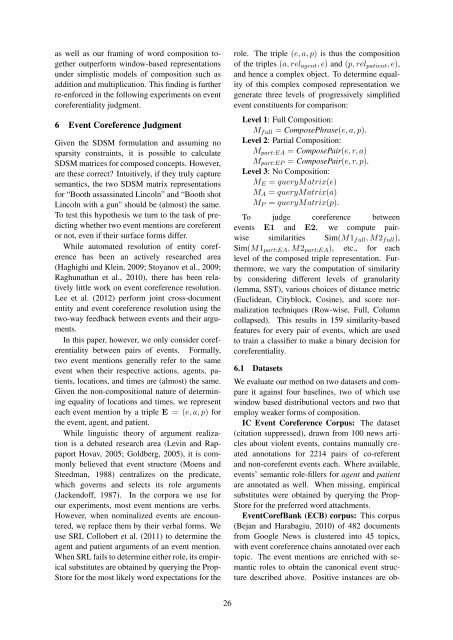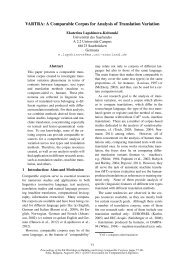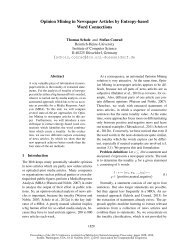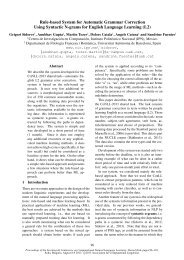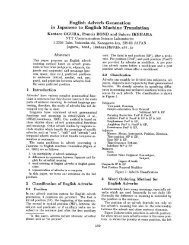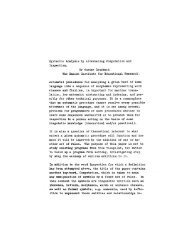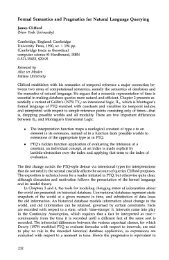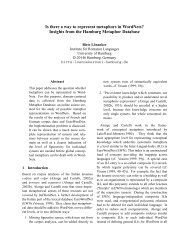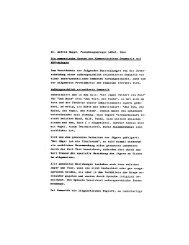Vector Space Semantic Parsing: A Framework for Compositional ...
Vector Space Semantic Parsing: A Framework for Compositional ...
Vector Space Semantic Parsing: A Framework for Compositional ...
Create successful ePaper yourself
Turn your PDF publications into a flip-book with our unique Google optimized e-Paper software.
as well as our framing of word composition together<br />
outper<strong>for</strong>m window-based representations<br />
under simplistic models of composition such as<br />
addition and multiplication. This finding is further<br />
re-en<strong>for</strong>ced in the following experiments on event<br />
coreferentiality judgment.<br />
6 Event Coreference Judgment<br />
Given the SDSM <strong>for</strong>mulation and assuming no<br />
sparsity constraints, it is possible to calculate<br />
SDSM matrices <strong>for</strong> composed concepts. However,<br />
are these correct? Intuitively, if they truly capture<br />
semantics, the two SDSM matrix representations<br />
<strong>for</strong> “Booth assassinated Lincoln” and “Booth shot<br />
Lincoln with a gun" should be (almost) the same.<br />
To test this hypothesis we turn to the task of predicting<br />
whether two event mentions are coreferent<br />
or not, even if their surface <strong>for</strong>ms differ.<br />
While automated resolution of entity coreference<br />
has been an actively researched area<br />
(Haghighi and Klein, 2009; Stoyanov et al., 2009;<br />
Raghunathan et al., 2010), there has been relatively<br />
little work on event coreference resolution.<br />
Lee et al. (2012) per<strong>for</strong>m joint cross-document<br />
entity and event coreference resolution using the<br />
two-way feedback between events and their arguments.<br />
In this paper, however, we only consider coreferentiality<br />
between pairs of events. Formally,<br />
two event mentions generally refer to the same<br />
event when their respective actions, agents, patients,<br />
locations, and times are (almost) the same.<br />
Given the non-compositional nature of determining<br />
equality of locations and times, we represent<br />
each event mention by a triple E = (e, a, p) <strong>for</strong><br />
the event, agent, and patient.<br />
While linguistic theory of argument realization<br />
is a debated research area (Levin and Rappaport<br />
Hovav, 2005; Goldberg, 2005), it is commonly<br />
believed that event structure (Moens and<br />
Steedman, 1988) centralizes on the predicate,<br />
which governs and selects its role arguments<br />
(Jackendoff, 1987). In the corpora we use <strong>for</strong><br />
our experiments, most event mentions are verbs.<br />
However, when nominalized events are encountered,<br />
we replace them by their verbal <strong>for</strong>ms. We<br />
use SRL Collobert et al. (2011) to determine the<br />
agent and patient arguments of an event mention.<br />
When SRL fails to determine either role, its empirical<br />
substitutes are obtained by querying the Prop-<br />
Store <strong>for</strong> the most likely word expectations <strong>for</strong> the<br />
role. The triple (e, a, p) is thus the composition<br />
of the triples (a, rel agent , e) and (p, rel patient , e),<br />
and hence a complex object. To determine equality<br />
of this complex composed representation we<br />
generate three levels of progressively simplified<br />
event constituents <strong>for</strong> comparison:<br />
Level 1: Full Composition:<br />
M full = ComposePhrase(e, a, p).<br />
Level 2: Partial Composition:<br />
M part:EA = ComposePair(e, r, a)<br />
M part:EP = ComposePair(e, r, p).<br />
Level 3: No Composition:<br />
M E = queryMatrix(e)<br />
M A = queryMatrix(a)<br />
M P = queryMatrix(p).<br />
To judge coreference between<br />
events E1 and E2, we compute pairwise<br />
similarities Sim(M1 full , M2 full ),<br />
Sim(M1 part:EA , M2 part:EA ), etc., <strong>for</strong> each<br />
level of the composed triple representation. Furthermore,<br />
we vary the computation of similarity<br />
by considering different levels of granularity<br />
(lemma, SST), various choices of distance metric<br />
(Euclidean, Cityblock, Cosine), and score normalization<br />
techniques (Row-wise, Full, Column<br />
collapsed). This results in 159 similarity-based<br />
features <strong>for</strong> every pair of events, which are used<br />
to train a classifier to make a binary decision <strong>for</strong><br />
coreferentiality.<br />
6.1 Datasets<br />
We evaluate our method on two datasets and compare<br />
it against four baselines, two of which use<br />
window based distributional vectors and two that<br />
employ weaker <strong>for</strong>ms of composition.<br />
IC Event Coreference Corpus: The dataset<br />
(citation suppressed), drawn from 100 news articles<br />
about violent events, contains manually created<br />
annotations <strong>for</strong> 2214 pairs of co-referent<br />
and non-coreferent events each. Where available,<br />
events’ semantic role-fillers <strong>for</strong> agent and patient<br />
are annotated as well. When missing, empirical<br />
substitutes were obtained by querying the Prop-<br />
Store <strong>for</strong> the preferred word attachments.<br />
EventCorefBank (ECB) corpus: This corpus<br />
(Bejan and Harabagiu, 2010) of 482 documents<br />
from Google News is clustered into 45 topics,<br />
with event coreference chains annotated over each<br />
topic. The event mentions are enriched with semantic<br />
roles to obtain the canonical event structure<br />
described above. Positive instances are ob-<br />
26


